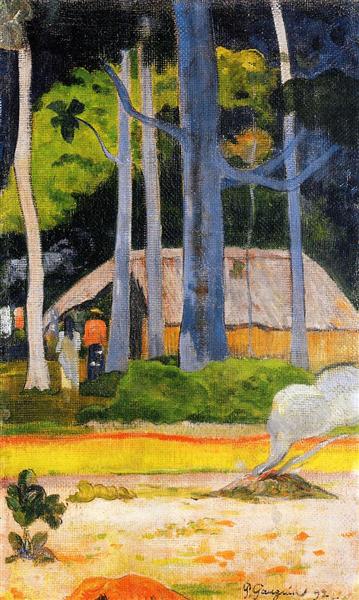Beskrivning
Paul Gauguin, one of the most influential figures of Post-Impressionism, presents us with "Cabin Under the Trees" (1892) a work that embodies his unique vision and his artistic evolution towards a more symbolic and emotive language. This oil on canvas reflects Gauguin's interest in the representation of nature and space, as well as his desire to express the spirituality and simplicity of rural life, concepts that would become pillars of his later work.
The composition of “Cabin Under the Trees” is characterized by a strong sense of settlement in nature. The cabin, a modest shelter, sits partially hidden among a leafy stand of trees, suggesting both protection and isolation. Gauguin employs a remarkable use of form and color; the simple lines of the cabin’s structure contrast with the richness of the natural surroundings. The palette he uses is an example of the distinctive style Gauguin would develop throughout his career, where vibrant hues and unconventional combinations revolutionize the perception of color in painting.
Looking at the work, the trees surround the cabin with an almost palpable exuberance, creating an atmosphere of calm and tranquility. The intense greens and browns offer a direct connection to the earth, evoking a sense of harmony with the surroundings. These plant elements not only frame the cabin, but also infuse the work with an almost tangible vitality, suggesting that nature has its own language and dynamics that speak to observers.
While the hut is presented as a sign of life and shelter, the work lacks the presence of human figures, an aspect that resonates with Gauguin’s philosophy of drawing emotional depth from the landscape itself rather than relying on figurative narrative. This emptiness provokes a reflection on the role of man in the natural environment, suggesting a coexistence that provokes both a sense of belonging and loneliness.
Gauguin's technique is also distinguished in this work by his treatment of color, where each hue seems charged with emotion and meaning. The depiction of light and shadow is not based on imitation of natural phenomenon, but on the creation of an alternative reality that resonates with the viewer on an emotional and symbolic level. This approach is not limited to "Cabin Under the Trees" but is a defining characteristic of his later work, especially in works that explore deeper themes of human existence and spirituality.
Gauguin is often associated with his period in Tahiti, where his quest for purity and simplicity led him to create some of his most iconic works. However, in “Cabin Under the Trees” we can see the foundations of this desire for simplicity and connection with nature, elements that foreshadow his future direction. Through this work, Gauguin invites us to contemplate our relationship with the natural world, providing us not only with a visual representation, but also with a deep sense of introspection and reflection.
In conclusion, “Cabin Under the Trees” serves as a testament not only to Gauguin’s exceptional talent as a painter, but also to his ability to present complex subjects with simplicity and beauty. It is a work that invites viewers to experience and explore their own connection to nature and to reflect on the stories that inhabit the spaces we often take for granted. This piece will forever stand as a beacon in the evolution of modern art, emitting echoes of an artistic vision that continues to influence to this day.
KUADROS ©, a famous painting on your wall.
Hand-made oil painting reproductions, with the quality of professional artists and the distinctive seal of KUADROS ©.
Painting reproduction service with satisfaction guarantee. If you are not completely satisfied with the replica of your painting, we will refund 100% of your money.

